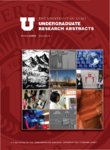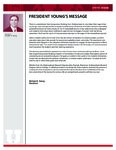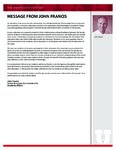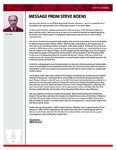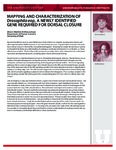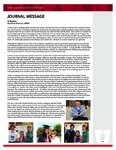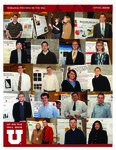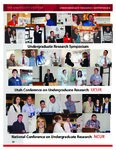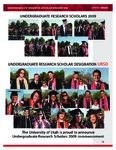Contents | 7 of 17
Undergraduate Abstracts of undergraduate research abstracts vol 9 - Part 2
| Title | University of Utah Undergraduate Research Abstracts, Volume 9, Spring 2009 |
| OCR Text | Show A Message from President Young.....2 A Message from John Francis.....3 A Message from Steve Roens.....4 Undergraduate Abstracts.....5 A Message from Jill Baeder.....69 Research Posters on the Hill.....70 Charles H. Monson Prize Winner.....99 Undergraduate Research Conferences.....104 Undergraduate Research Scholars.....105 Psychology Senior Thesis Program.....106 Honors Program.....114 Alphabetical Index.....187 |
| Subject | University of Utah -- Students -- Periodicals |
| Publisher | J. Willard Marriott Library, University of Utah |
| Date | 2009 |
| Type | Text |
| Format | application/pdf |
| Language | eng |
| Rights Management | Digital image © copyright 2009, University of Utah. All rights reserved. |
| Holding Institution | Office of Undergraduate Studies Sill Center 195 S. Central Campus Dr. Salt Lake City, UT 84112 Office of Undergraduate Studies Sill Center 195 S. Central Campus Dr. Salt Lake City, UT 84112 |
| Source Material | Bound journal |
| Source Physical Dimensions | 14 cm x 21 cm |
| ARK | ark:/87278/s6j966gm |
| Temporal Coverage | Spring 2009 |
| Setname | uu_urop |
| ID | 417424 |
| Reference URL | https://collections.lib.utah.edu/ark:/87278/s6j966gm |
Page Metadata
| Title | Undergraduate Abstracts of undergraduate research abstracts vol 9 - Part 2 |
| OCR Text | Show THE UNIVERSITY OF UTAH 37 UNDERGRADUATE RESEARCH ABSTRACTS SEAT POSITION AND POWER ABSORPTION DURING ECC CYCLING Eccentric (ecc) muscle contractions have been reported to create high force production despite a low demand for oxygen. Further, specific rehabilitation training using ecc egrometry has been a useful clini-cal tool for increasing muscle mass and isometric strength in knee extensors muscles. The purpose of this investigation was to determine if changes in seat position would alter the power absorption strategies used during ecc cycling. Eight eccentrically trained males participated in this study. Participants per-formed two separate 30-sec ecc cycling trials at a "short" and "long" seat position, 125 and 170 degrees respectively. Seat position was determined by measuring knee joint angle (lateral malleolus to femoral condyle to greater trochanter) with a goniometer. Participants resisted the reverse moving pedals at 60 rpm at a specified target power that was 20% of each individual's maximum concentric power. Data was sampled at 120Hz. Joint powers at the ankle, knee, and hip were calculated using inverse dynamic tech-niques. Joint powers were averaged over a full revolution and over the extension and flexion phases. Repeated measures procedures were used to asses changes in joint powers (alpha = .05). In conclusion, changing seat position does not alter power absorption strategies during ecc cycling. Matthew L. Madigan, Steven J. Elmer, (James C. Martin) Department of Exercise and Sports Science University of Utah Matthew L. Madigan James C. Martin 38 UNDERGRADUATE RESEARCH ABSTRACTS SPRING 2009 ZEBRAFISH AS A GENETIC MODEL FOR T CELL MALIGNANCY T-cell leukemia and lymphoma are common cancers, but the genetic mutations and molecular pathways underlying these diseases are poorly understood. Previous studies have used human genes transgeni-cally placed in zebrafish (Danio rerio) to demonstrate that these animals can develop similar diseases. We have used zebrafish as a genetic model to discover new gene candidates causing leukemia and lym-phoma. Unlike prior work, our project uses mutations in the zebrafish genome to induce disease. To detect leukemia in affected fish, we have utilized Green Fluorescent Protein (GFP) linked to a gene pro-moter (lck) expressed only by zebrafish T-cells. This technique allows T-cells to be visualized in vivo via fluorescent microscopy. Diseased fish identified by this method are then used in several different experi-ments. Leukemic fish are out-bred to wild type (WT) animals for genetic mapping studies. Cancerous cells from leukemic fish can be transplanted into WT fish to create large groups of animals having the exact same cancer, which are then subjected to differing experimental conditions. Tumor-bearing fish can also be irradiated to study the time and nature of treatment responses, and subsequent cancer relapses. Cancer cells can also be purified to assess their ‘clonality,' gene expression patterns, and for chromosomal analyses. Collectively, this model provides an experimental platform for discovery of new cancer-causing genes, as well as an understanding of the downstream molecular events that permit dis-ease progression and relapse. Matthew J. Mau (J Kimble Frazer, Nathan Meeker, Nikolaus Trede) Department of Pediatric Hematology/Oncology University of Utah Matthew John Mau Kimble Frazer THE UNIVERSITY OF UTAH 39 UNDERGRADUATE RESEARCH ABSTRACTS MONO-PAINTING TRANSFERRED TO LITHOGRAPHIC FIXED MATRIXES While it is possible to paint directly to a lithographic matrix, (stone or aluminum plate) the nature of the process does not allow for any mistakes once the ink (used to paint with) is on the matrix it will print, even if it is wiped away. Using a monotype technique of painting on 1/16" Lexan allows for the ink to be move and removed without becoming fixed. The ink is transferred by running the Lexan ink side down on a matrix, though the press. This results in a fixed matrix that appears to be a mono-print. The first thing I did was find the right ink and modifiers and, since stones and aluminum plates are slightly different I decided to concentrate on the aluminum plate first. I found that traditional relief black with #3 oil (to loosen) and miracle gel (to lessen tack), transferred a good balance of the light and black areas. Once a good transfer was accomplished I needed to fix the image to the matrix by etching it. After losing a few images by etching them improperly, I found it was best to leave the plate for two hours then do a light etch of just gum aribic (the weakest etch). Let it sit over night and then etch with ? TAPEM in the lighter values up to straight TAPEM in the blackest blacks. I now have an image that appears to be a mono-print that could be printed hundreds of times. In the images I used the ideas and concept of my previous works. Orb trees (as nature) and robots (as industrial man, machine, etc.) to show the way we treat mother nature and the harm it does to us and her. A second analogy is the orb trees are my lymphoid system and the robots are my cancer which I fought from 2005-06. These two metaphors are very related since I am a part of nature and I feel my cancer has come from pollution, chemicals in food and other products created by industrial man. Andrew McReynolds, (Justin Diggle) Department of Art and Art History University of Utah Andrew McReynolds 40 UNDERGRADUATE RESEARCH ABSTRACTS SPRING 2009 ESTIMATING SNOW ACCUMULATION ON THE GREENLAND ICE SHEET USING SATELLITE DATA Glaciers and ice sheets add mass by the seasonal accumulation of snow on their surface and lose mass when snow and ice melt in the process of ablation. The annual mass balance of an ice sheet is defined as the total difference between these two mechanisms. Mass balance is extremely sensitive to precipita-tion variability and a critical indicator of regional and global climate change. However, there are only 18 automatic weather stations (AWS) measuring snow accumulation on the entire Greenland Ice Sheet (GIS). Recent research by other scientists has shown the potential to estimate annual snow accumulation on the GIS using radar satellite data. When snow accumulates on the previous year's summer melt layer it displays an inverse relationship with increasing snow depth causing a reduction in returned radar ener-gy. As radar waves propagate through the snow layer to and from ice structures in the underlying gla-cier, they are attenuated by absorption in the snow and by volume scattering within the snow layer which reflects electromagnetic energy away from the radar. The focus of this research is to identify and analyze areas on the GIS that exhibit this distinct spectral characteristic. During the 2002 summer melt season, the GIS sheet experienced relatively warm temper-atures which formed an extensive layer of ice on the surface of the glacier. The following winter was characterized by a high pressure ridge over the Norwegian Sea and a low pressure trough at the conti-nent‘ s southern tip which resulted in frequent storms and increased precipitation. Therefore, the winter snow accumulation beginning in 2002 will be the initial test case. SeaWinds is a Ku-band, 13.4 GHz, 2.2 cm, microwave imaging radar on NASA's QuikSCAT satellite. It cov-ers the entire GIS twice daily on ascending and descending orbits with a resolution of 25x25 km. Modeled snow accumulation is required for comparison with QuikSCAT radar returns considering the limited number of AWS sites. The Polar Mesoscale Model (PMM5) models atmospheric conditions using initial and lateral boundary conditions derived from terrestrial and isobaric meteorological data. It is specifically calibrated for polar conditions. Time series of QuikSCAT measurements acquired between 2000 and 2003 along with annual accumula-tion data from PMM5 are used to develop a snow accumulation algorithm. The first step is determining which areas on the GIS are viable candidates for this technique. Once the pixels are identified, a correla-tion analysis between QuikSCAT radar returns and PMM5 modeled data will be performed. Preliminary results for six test pixels on the GIS indicate a relationship between QuikSCAT data and man-ually selected pixels on a climatological PMM5 accumulation map. Larger negative slopes from linearly regressed QuikSCAT time series correspond to larger mean accumulation rates suggesting a decrease in radar returns over time with increased snowfall. Further research will use annual PMM5 accumulation maps with multi-year QuikSCAT data on hundreds of pixels. Julie Miller (Richard R. Forster) Department of Geography University of Utah Julie Miller Richard R. Forster THE UNIVERSITY OF UTAH 41 UNDERGRADUATE RESEARCH ABSTRACTS COLLAGEN CROSS-LINKS IN HORSES WITH HYPERELASTOSIS CUTIS. Hyperelastosis Cutis (HC, aka HERDA) is a genetic disorder affecting primarily the skin of American Quar-ter Horses. Affected animals have fragile skin with large wounds developing upon saddling. The analy-sis of the pedigree of affected animals supports an autosomal recessive pattern of inheritance. The skin findings in HC are strikingly similar to those of the human disorder Ehlers-Danlos Syndrome type VI / kyphoscoliotic type (EDS VI). EDS VI is caused by deficiency of collagen lysyl hydroxylase, leading to decreased hydroxylysine residues in collagen. Hydroxylysine is the amino acid precursor of the most stable cross-links of collagen, pyridinium cross-links. There are two forms of pyridinium cross-links, pyridinoline (PYD), derived from three hydroxylysine residues, and deoxypyridinoline (DPD), derived from one lysine and two hydroxylysine residues. Decreased concentrations of hydroxylysine impair the production of these cross-links and decrease the strength of collagen. Both cross-links are found in con-nective tissues and are excreted in the urine as products of collagen degradation. In normal individuals, the concentration of PYD is high in comparison to that of DPD, with a ratio DPD/PYD = 0.20-0.30, while in individuals with EDS VI the ratio is reversed (DPD/PYD > 3). Horses with HC had the same abnormal pattern of pyridinium cross-links observed in patients with EDS VI, with a markedly elevated ratio DPD/PYD in urine and tissues, supporting the hypothesis that an enzyme analogous to human lysyl hydroxylase is impaired in HC. In order to test this hypothesis and to better understand the mechanism of formation of pyridinium cross-links, we are studying the hydroxylation of collagen in fibroblasts from normal and HC horses, using oligopeptides as substrates. The products of the reaction (hydroxylated oligopeptides) will be monitored by tandem mass spectrometry (MS/MS). This study indicates that horses with HC might represent a natural model of human Ehlers-Danlos syndrome type VI. Natalie Jane Morlan (Elisabeth Schwarz, Cyprianna Swiderski, Marzia Pasquali) Department of Pathology and ARUP Institute for Clinical and Experimental Pathology, Mississippi State University University of Utah Natalie Jane Morlan Marzia Pasquali 42 UNDERGRADUATE RESEARCH ABSTRACTS SPRING 2009 USE ONLY AS DIRECTED: A SURVEY OF OPIOID PAIN MEDICATION DISPOSAL AFTER PEDIATRIC FRACTURE Background: Accidental ingestion and abuse of prescription drugs is an increasing public health problem in the U.S. CDC data show that in 2005, poisoning was second only to motor vehicle collision as a cause of unintentional injury death. In a national survey, more than 6 million people reported non-medical use of prescription drugs. Opioid analgesia is often prescribed for acute fracture pain in children. Medication remaining in the home after the intended duration of use poses a risk for accidental or intentional inges-tion. Previous research has shown that children use pain medicine for approximately three days after a fracture. However, no studies to date have examined what families do with unused medication. Objective: To describe the storage and disposal of opioid analgesics, after their intended period of use, in households of children treated for isolated fractures. Design/Methods: At a pediatric tertiary care emergency department (ED), we prospectively enrolled a convenience sample of parents and guardians whose children were diagnosed with an isolated fracture and discharged from the ED. Subjects were excluded if the child was taking chronic pain medications, had multiple other traumatic injuries, or had a skull fracture. We collected patient demographic informa-tion and conducted a telephone survey 6-8 weeks after the ED visit. Participants were queried regarding the prescribed pain medication utilization, storage and disposal. Results: We enrolled 127 parents and guardians and successfully contacted 91 (72%) by phone. Overall, 78/91 (86%) received a prescription for an opioid analgesic. Of these, 61/78 (78%) filled the prescription and 48/61 (79%) had leftover medication. Of those with leftover medication, 34/48 (71%) still had the medication in their home. Participants reported storing medication in the medicine cabinet [20/34 (59%)] and the kitchen [11/34 (32%)]. Only one participant stated that the medicine was in a locked cabinet. Fourteen of the 48 (29%) disposed of the medication. Conclusions: The majority of parents and guardians do not administer all of the opioid analgesics prescribed to their children with isolated fractures. Most of these medications remain in an unsecured location after the intended period of use, posing a potential risk for accidental overdose or intentional misuse. Lacie Newland (Amanda E Hoehler, Joyce V Soprano, Nanette C Dudley) Department of Pediatrics, Health Sciences LEAP University of Utah Lacie Newland Amanda E Hoehler THE UNIVERSITY OF UTAH 43 UNDERGRADUATE RESEARCH ABSTRACTS RNA AMPLIFICATION OF DORSAL ROOT GANGLION NEURONS RETROGRADELY LABELED WITH DI-I SIGNALING CHRONIC PAIN AND FATIGUE In muscles, there are neurons of groups III and IV that correspond to two kinds of afferents or nerves. In previous studies regarding the responses of these afferents in skeletal muscle, single mechanical stimuli have been used to evoke responses. Chemical stimuli are equally important, as they are responsible for the pain and fatigue states after and during mechanical stimuli. Unlike previous studies involving analy-sis of single metabolites, cultured dorsal root ganglion (DRG) neurons were exposed to combinations of the chemical metabolites responsible for pain and fatigue, including lactic acid, ATP, and protons (altered pH). Key receptors of these metabolites were found to be ASICs, P2X, and TRPV. By using a com-bination of the metabolites, which are agonists for these receptors, the responses were enhanced, viewed, and analyzed by calcium imaging showing that the metabolites are crucial in signaling pain and fatigue in skeletal muscle. Currently, injection of a florescent dye called Di-I into the lower leg muscles of nine day old mice allows the sensory DRG neurons from the injected muscles to fluoresce when viewed under the microscope. Carrageenan injection a day before the dissection causes inflammation which evokes similar response as pain and fatigue.Using the Di-I fluorescence to identify individual ret-rogradely labeled cells from muscle, small numbers of labeled cells are collected and quick-frozen. Nor-mally, the RNA from whole DRGs is extracted, and then using ABI's Multiscribe reverse-transcriptase, is converted into a cDNA library, then is analyzed using real-time quantitative PCR. Due to the small num-ber of individual Di-I labeled cells harvested in this procedure, the yield of cDNA is too low to perform meaningful real-time quantitative PCR. Thus, a protocol is being developed to amplify the RNA from the small amount of Di-I labeled cells in order for the analysis to be successful. The protocol to be used is TransPlex® Whole Transcriptome Amplification Kit from Sigma® with JumpStart™ Taq DNA Polymerase, which is being analyzed to determine its effectiveness in RNA amplification. Sean Gowen, Tuyet Nguyen (Ron Hughen, Alan Light) Department of Anesthesiology, Health Sciences LEAP University of Utah Tuyet Nguyen Sean Gowen Alan Light 44 UNDERGRADUATE RESEARCH ABSTRACTS SPRING 2009 THE HISTORY OF UTAH'S JUVENILE JUSTICE REFORM Thirty years ago Utah's Juvenile Justice System underwent a major reform, as it evolved from an institu-tional system to a rehabilitative approach. It is imperative that we understand the impetus for this reform and the dynamics that helped maintain the systemic changes. We can attempt to ensure that history will not be repeated through gaining an understanding of the circumstances that led up to the reform. There is currently limited research conducted on this subject, therefore making it crucial now, while we still have access to key players who were involved in the reform and have institutional memory. This history is largely unknown to many current judges, social workers, and policy makers working in the Juvenile Justice arena. We addressed the lack of documentation by conducting qualitative interviews with key players who had pivotal roles in the reform. These interviews provided factual data concerning the reform, but more importantly they identified the overall dynamics that perpetuated abuse and therefore could identify dangerous patterns of dealing with juvenile justice in the future. This information and education is needed for professionals to better serve the youth whom are currently part of the Juvenile Justice System. Natalie Peacock (Robin Davis) Department of Social Work University of Utah Natalie Peacock Robin Davis THE UNIVERSITY OF UTAH 45 UNDERGRADUATE RESEARCH ABSTRACTS ENGINEERING NANOPARTICLE ASSEMBLY THROUGH CONTROLLED SURFACE CHEMISTRY The field of metal nanoparticle synthesis and organization has become important in detection systems for biological and chemical systems, particularly in those based on surface plasmon resonance. This is due to the ability to change the unique optical properties of metal nanoparticles through altering size, organization, and magnetism. The use of "click chemistry" techniques, the ability to bind nanoparticles together through the use of simple organic molecules and reactions, lends a new and effective route of organizing metal nanoparticles into assemblies with unique optical properties. An appealing aspect of click chemistry is the ability to use various small organic molecules as linkers to control the distances between particles, altering the optical properties of these assemblies. Nanoparti-cle dimers are especially interesting because of their use as substrates in surface-enhanced Raman spectroscopy (SERS), where the dimers act to produce strong electromagnetic field enhancements. In addition, the sheer variety by which nanoparticle dimers may be synthesized with different size and shape combinations makes this a highly versatile and valuable system. The methods in this project make use of a templating process to limit specific chemical groups to spa-tial regions of the surface of nanoparticles. Metal nanoparticles were synthesized through reduction with sodium citrate, bound to a surface. The particles were then reacted with a capping ligand, to enhance monodispersion of nanoparticles and thus avoid useless aggregations. The nanoparticles were then released from the surface and nonfunctionalized regions were treated with secondary ligands. At this point a wide variety of homodimers and heterodimers may be produced with a simple coupling reaction, such as that favored by the "click chemistry" techniques. In this way, altering dimer length through "click" linkers has a significant impact on nanopartical optical properties. Further research is planned to study methods of changing linker lengths through "click" chemistry techniques. Christian Pecchia-Bekkum (Jennifer Shumaker-Parry) Department of Chemistry University of Utah Christian Pecchia-Bekkum Jennifer Shumaker-Parry 46 UNDERGRADUATE RESEARCH ABSTRACTS SPRING 2009 THE IMPACT OF PATIENT PROVIDER COM-MUNICATION ON INDIVIDUALS WITH A FAMILY HISTORY OF CANCER BACKGROUND Individuals with a family history of cancer may be at increased risk of cancer and thus are an important population to target for increasing their health behaviors. Health care providers (HCP) can initiate dis-cussions of general health behavior practices (e.g., diet and stress management) in light an individuals' family history of cancer. A provider who uses a prescriptive and directive communication style may block patient participation during the session and subsequent initiation of health practices. In contrast, HCPs who use a more facilitative approach are likely to elicit patient opinions, engender engagement in the interaction and thus promote personalized behavior change. With this style of provider communication, individuals are likely to become motivated to confront health concerns. In the present project, we com-pare directive vs. facilitative communication styles and assess the impact on participants with a family history of cancer. Research questions: Do participants rate the directive and facilitative communication conditions differ-ently? Does the facilitative communication style show increased mean heart rate compared to the direc-tive condition? Do participants in the facilitative condition indicate an increased likelihood to try health behaviors as compared to the directive condition? METHODS Participation was voluntary for people with a family history of cancer. Participants were randomized to either a directive or facilitative communication style condition. A series of questionnaires were answered by the participant. According to the assigned communication style, the participant had a brief cancer interview session with a confederate nursing student. Heart rate was recorded at baseline and during the session. ANALYSIS Descriptive statistics were used to examine demographics. Analysis of Variance and Covariance were used to compare mean differences for the two conditions. RESULTS Participants rated the "nurse" as more interested in their explanations (F (1, 26) = 3.55, p = .09 and thoughtful answers in the facilitative condition (F (1, 26) = 3.32, p = .08). During the task, the mean HR was higher for participants assigned to the facilitative communication style (M = 73.56 vs. 76.00). Com-munication style showed no difference on participants' intentions to try health behaviors suggested by the confederate nursing student. CONCLUSION From this preliminary analysis of a larger, ongoing project, some trends in the data are evident. Partici-pants rated the two communicates styles differently and their ratings were consistent with the intended manipulation (i.e., directive vs. facilitative). The participants' higher HR in the facilitative condition may be indicative of increased engagement in the interaction as compared to the directive communication condition. However, communication style did not have a significant effect on participants' intentions to follow through with health behaviors. Priscilla Perea (Lee Ellington, Evin Sayin) College of Nursing University of Utah Priscilla Perea Lee Ellington THE UNIVERSITY OF UTAH 47 UNDERGRADUATE RESEARCH ABSTRACTS ENDOGENOUS CERAMIDE BIOSYNTHESIS IMPAIRS INSULIN-MEDIATED NO PRO-DUCTION IN BAECS VIA MECHANISMS INDEPENDENT OF AKT We have shown that inhibiting ceramide synthesis in mice using myriocin (Myr) prevents high fat diet-induced vascular ceramide accrual, arterial dysfunction, and systemic hypertension. Phosphorylated (p) endothelial nitric oxide (NO) synthase (p-eNOS) to total eNOS protein was abolished in arteries from mice that consumed high-fat vs. standard chow, but was restored to control values when fat-fed mice were treated concurrently with Myr. These findings suggest that ceramide biosynthesis in response to fat-feeding might evoke cardiovascular complications in mice by lowering arterial p-eNOS to total eNOS. To explore this hypothesis we first treated bovine aortic endothelial cells (BAECs) with the satu-rated free fatty acid palmitate (Pal) to evoke endogenous ceramide biosynthesis. First, when BAECs are incubated with 500 uM Pal for 3 hours ceramide increases (p<0.05) 1.6 ± 0.1-fold, and this response is abolished when cells are co-incubated with 10 uM Myr (HPLC, n=6). Second, we examined whether insulin-stimulated NO production by BAECs is impaired by ceramide. 100 nM insulin evoked 1.65 ± 0.10- fold increases (p<0.05) in NO production by BAECs. These increases were negated by Pal, and were restored by concurrent treatment of Pal with Myr (amperometric probes, n=9-31). Thus, ceramide syn-thesis impairs insulin-stimulated NO production. Third, we determined if ceramide-induced reductions in insulin-mediated NO production are precipitated by lower p-eNOS to total eNOS. Insulin-evoked 1.73 ± 0.09-fold increases (p<0.05) in p-eNOS S1177 that were abolished by Pal, but were restored by con-current treatment with Myr (western immunoblotting, n=16-32, Panel A). Thus, ceramide synthesis impairs insulin-stimulated p-eNOS S1177. Fourth, in the same samples we determined whether ceramide-induced reductions in p-eNOS S1177 result from defective upstream signaling via Akt/PKB. Insulin-stimulated p-Akt at S473/T308 was intact in the absence and presence of Pal ± Myr (western immunoblotting, n=16-29, Panel B). We conclude that endogenous ceramide biosynthesis impairs insulin-mediated NO production in BAECs via mechanisms independent of AKT. Funded in part by the National Institutes of Health and American Diabetes Association. Dix H. Pettey, Lloyd J. Wilson, Derrick C. Gale, Quan-Jiang Zhang, Jason M. Tanner, (J. David Symons) College of Health and Division of Endocrinology, Metabolism, and Diabetes University of Utah Dix H. Pettey Derrick C. Gale Lloyd J. Wilson Jason M. Tanner J. David Symons 48 UNDERGRADUATE RESEARCH ABSTRACTS SPRING 2009 NERVE CONTAINMENT SYSTME FOR THE UTAH SLANTED ELECTRODE ARRAY (USEA) The Utah Slanted Electrode Array (USEA) consists of up to 100 electrodes of varying length that project from a 4x4x0.2 mm silicon substrate . The varied electrode lengths allow stimulation of both afferent and efferent nerve fibers at various widths and depths within the nerve while leaving other nerve fibers unaffected. However, after implantation, connective tissue develops between the electrodes and the nerve fibers which cause the implanted USEAs to loosen and detach from the nerve. The goal of this project is to create a containment system to prevent this detachment. In this study, the sciatic nerves of twelve rats were encapsulated with 7.5x11.5 mm metal mesh screens. To explore the body's immune response to different materials and coatings for the capsule, four screen variations were used including a gold screen with parylene coating, a gold screen without parylene coating, a tantalum screen with pary-lene coating, and a tantalum screen without parylene coating. Because the electrode tips are fragile and susceptible to damage during implantation, the effectiveness of a new method for encapsulating the array and nerve was also introduced. After 60 days, the rats were sacrificed and the sciatic nerves were observed. A subjective scale based on the amount of nerve and muscular discoloration, muscle integra-tion into screen, screen deformation, and leaky blood vessels determined the in vivo response score. Of the four screen combinations, gold mesh with parylene coating yielded the highest average followed by gold without parylene, tantalum with parylene, and tantalum without parylene. This demonstrates that gold produces the best in vivo response and that parylene coating improves the screen's biocompatibili-ty. This study also revealed the need for a new containment system design with closer screen wrappings around the nerve, less screen material, and a more secure suturing method. These results guided the design of a second containment system that is currently undergoing similar testing. 1A Multielectrode Array for Intrafascicular Recording and Stimulation in Sciatic Nerve of Cats, Branner, A.; Normann, R. Brain Research Bulletin, Vol. 51, No. 4, pp. 293-295, 2000 Creighton Petty (Richard Normann) Department of Bioengineering University of Utah Figure 1: The Utah Slanted Electrode Array (USEA) Figure 2: The USEA in nerve with tips able to stimulate neural fibers in nearly all areas Figure 3: The USEA containment system during implantation Figure 4: The USEA containment system after 60 days of implantation Creighton Petty Richard Normann THE UNIVERSITY OF UTAH 49 UNDERGRADUATE RESEARCH ABSTRACTS FUNCTION OF MITOCHONDRIAL STRESS-RESPONSIVE PROTEIN LMS1 Mitochondria produce the majority of ATP to power basic cellular function and their dysfunction causes many human diseases. Yet, one third of an estimated 1100 mitochondrial proteins remain uncharacter-ized. The Rutter Lab has designated one of these proteins Longevity Associated Mitochondrial Stress Responsive 1 (Lms1), which is essential for mitochondrial function by an unknown mechanism. The mechanism of Lms1 action may be elucidated by determining its interacting proteins and subcellular localization. We aimed to clone HA-tagged and GFP-tagged Lms1 constructs for immunoprecipitating Lms1 protein complexes and for visualizing Lms1 by fluorescence microscopy, respectively. We cloned, identified, and amplified epitope-tagged Lms1 viral expression constructs. We ligated viral vectors to epitope-tagged Lms1 cDNA. We transformed bacteria with the resultant plasmids, identified transformants by antibiotic selection, cultured colonies from individual transformants, isolated plasmids from these cultures, and then identified positive clones by digesting these plasmids with restriction enzymes. These plasmids were amplified for production of retroviruses. Cells infected with retrovirus stably expressed HA- or GFP-tagged Lms1 demonstrating that our new viral constructs were functional. Experiments utilizing these vectors that aim to find Lms1 interacting proteins and determine Lms1 sub-cellular localization are ongoing. The results of these studies will better explain how Lms1 functions and ultimately provide new insight into mitochondrial biology and its interaction with human disease. John Pham (Eric Taylor) Department of Biochemistry University of Utah John Pham Eric Taylor 50 UNDERGRADUATE RESEARCH ABSTRACTS SPRING 2009 PREPARATION AND CHARACTERIZATION OF MTS AND AE-8 SURFACE GRADIENTS Many biomaterials on the market today still suffer from lack of biocompatibility when implanted into the living tissue. Current methods of surface modifications create uniformly modified surfaces, and thus do not capture the richness and complexity of the molecularly diverse environment found in natural tis-sue. Here we report on a novel approach of creating model material surfaces with surface gradients that posses mixed chemistry characteristics. These surfaces are designed for use in screening of surface parameters that would minimize blood proteins and platelet interactions. Two types of the surface chemistry gradients on fused silica were prepared and characterized: (1) a thiol-to-sulfonate surface gra-dient was prepared by deposition and subsequent selective UV oxidation of 3-mercaptopropyl-trimethoxysilane (MTS), and (2) an amine-to-sulfonate gradient was created from the MTS gradient (1) by reacting the surface thiol groups with N-[iodoethyl] trifluoroacetamide (AE-8). Both gradients have been characterized by using the water contact angle measurements and X-ray photoelectron spec-troscopy (XPS). The MTS gradient revealed a change in the contact angle from ~64° for the thiol end of the gradient to 32° and 17° for the sulfonate side of the gradient, using 2 and 4 minutes UV irradiation, respectively. After the reaction with AE-8, the gradient displayed water contact angles ranging from ~50° (amine) to 10° (sulfonate). As thiol groups become increasingly oxidized by UV light to sulfonate groups, sulfur (S2p) peak appears as a doublet and a new nitrogen (N1s) peak appears after the reaction with AE-8. Lydia Potekhina, Yong-Xue Ding (Vladimir Hlady) Department of Bioengineering University of Utah Lydia Potekhina Vladimir Hlady THE UNIVERSITY OF UTAH 51 UNDERGRADUATE RESEARCH ABSTRACTS MEASURING IMMUNE RESPONSE TO MALARIA IN PIGEONS Malaria parasites infect many animals from birds to reptiles to mammals. Haemoproteus columbae is an avian malaria parasite species found in many species of pigeons and doves across the world. The parasite is vectored by a fly (Pseudolynchia canariensis) which feeds primarily upon pigeon blood and spends most of its time on the pigeon. Once the malaria parasite invades the red blood cells (erythrocytes) of the pigeon host, it consumes hemoglobin from erythrocytes. From this stage, the malaria parasite can be taken up by the fly in a blood meal and vectored to another pigeon host. The experiment currently in progress is to measure detrimental effects of the parasite to the pigeon host. To ensure that no previous parasite infection had taken place, the pigeons used were bred in captivity. Once the captive-bred nestlings matured into adults, they were injected intramuscularly with malaria parasite cultures obtained from infected flies. I am currently quantifying changes in feeding, behavior, weight, and immune response before and after the parasite's introduction to the host. Future plans include moving the experiment from captivity into the field. Shortly after hatching, half of the wild nestlings from several nests will be injected with malaria parasite cultures. The purpose of this experiment is to determine how the malarian parasite affects growth rate, parental care, and most importantly fledging success. Through use of experimental malaria infections, we hope to gain further knowledge of the detrimental effects and characteristics of Haemoproteus columbae in the host, and hope to apply our findings to better understand other malaria parasites. Blair Racker (Dale Clayton) Department of Biology University of Utah Hippoboscid flies (Pseudolynchia canariensis) from lab culture. Malaria parasites (Haemoproteus columbae) in the gametocyte stage in pigeon blood. Males stain pink and females stain blue with Giemsa stain. Blair Racker Dale Clayton 52 UNDERGRADUATE RESEARCH ABSTRACTS SPRING 2009 RECONSTRUCTING YOUTH AS ACTIVE PARTICIPATING CITIZENS Youth are often seen as "the future," yet their voices aren't listened to when passing laws that affect "the future" of this world. The topic of immigration not only affects the world, but local Salt Lake City youth as well. My research reports upon my involvement with local high school students participating in the Mestizo Arts and Activism program. Drawing upon participant observations and ethnographic field notes, my research considers young people's perspectives on immigration and their political decision-making. The youth's actions are influ-enced by their various backgrounds including living on the West Side, being students of color and some being undocumented immigrants. Those experiences have led them to become active in their commu-nity by creating surveys, a documentary, spoken word, an educational MySpace and online blog, empowering images, poetry, etc.. These projects educate the community about undocumented stu-dents' access to higher education, how stereotypes affect our daily lives by limiting our access to resources, and to create an interactive GIS map of the west side for the community. They have also come up with creative ways to disseminate their products by creating and distributing postcards, creat-ing a FaceBook Group and presenting at conferences - all in both Spanish and English. "These students have no legal right to vote and do not gain any privileges from advocating the rights of others; yet still they act as citizens." (Quijada, 2008) Mariana Ramiro (Caitlin Cahill) Department of City and Metropolitan Planning University of Utah Mariana Ramiro Caitlin Cahill THE UNIVERSITY OF UTAH 53 UNDERGRADUATE RESEARCH ABSTRACTS THE ROLE OF RACE IN PRESIDENTIAL POLITICS: ASSESSING AFRICAN AMERICAN VOTER TURNOUT FROM 2000 TO 2008. The 2008 election process was one to be remembered. The Republican and Democratic primaries were the most competitive primaries in recent history and the array of candidates included a viable female, Mormon, and African American. The 2008 election presented an ideal case study on the concept of identity politics, that is, does a candidate's identity stimulate voter turnout amongst those who person-ally identify with him or her? This study addresses that question with a specific focus on Barack Obama and the Black electorate. Utilizing data from the Pew Center for People and the Press, the Inter-Consor-tium for Political and Social Research (ICPSR), the George Mason United States Election Project, and CNN, this study analyzes how race mattered in the U.S. Presidential primary and general elections. Based upon the literature, this study made three hypotheses: 1) black voter turnout will increase at a higher rate than white voter turnout, 2) the difference in changes in turnout from 2000 to 2008 between black and white voters will be more prevalent in ideologically more liberal areas of the U.S., and 3) the younger cohort of black voters would react more strongly to a black candidate than older cohorts. The study shows that in certain areas of the United States black voter turnout increased at a higher rate than white voter turnout. Additionally, the data shows a slight regional bias, possibly relat-ing to the influence of ideology. Contrary to the third hypothesis, voter turnout increases were not more significantly prevalent amongst any age cohort within the black electorate. Race mattered in the 2008 election, but not in the traditional sense. Race was a significant mobilizer, and not a polarizer, in the 2008 election. Unlike many before him, Barack Obama was able to mobilize Black and White voters to support his candidacy. As the face of the electorate changes, his ability to be race transcendent allowed him to build a broad coalition of voters. Patrick Reimherr (John G. Francis) Department of Political Science University of Utah Patrick Reimherr John G. Francis 54 UNDERGRADUATE RESEARCH ABSTRACTS SPRING 2009 CORONARY ARTERY REMODELING IN THE CONOTRUNCAL BANDED CHICK EMBRYO The embryonic heart acutely increases developed pressure, and accelerates ventricular growth in response to increased afterload produced by conotruncal (Ct) banding. We hypothesized that altering the growth of the embryonic heart would affect the degree of vascularization in the coronary arteries. The outflow tract of a stage 21 (3?-d) chick embryo was tied with an overhand knot using a 10-0 nylon suture. The embryo was returned to the incubator until stage 36 (10-d) and 38 (12-d). Normal embryos were not operated. India ink in PBS (1:5) was injected into the left ventricle, and subsequently filled the coronary arteries. The heart was then fixed in diastole with 1 mg/Kg diltiazem in 4% formalin, and imaged under the stereophotomicroscope. Morphometric analysis (SigmaScan Pro) was performed to determine the maximum distance of the coronary artery, and the ventricular vertical length. Data are presented as mean±SEM (n?10), and analyzed by Student t-test. The lengths of the coronary arteries in Ct-banded hearts were distinctly shorter, and some displayed a contorted appearance. Coronary artery indexed by the ventricular length remained similar with the developing stage (0.47±0.01 at stage 36 vs 0.52±0.02 at stage 38, p>0.05); but drastically decreased at stage 36 in Ct-banded hearts (0.33±0.04) when compared to its comparable normal control (p<0.05). Coronary arteries in the normal heart under-go proportionate vascular growth and penetration during development. The constriction in the conotruncus alters the migration of mesenchymal tissue into the heart causing failure of absorption in the bulbus arteriosus, and misalignment of both great vessels. Vascular growth in the overloaded heart is compromised and rapidly decelerates that may cause the embryo lethality. Further studies will be conducted to elucidate the extent of this degradation in the coronary artery development. Kyle H Sabey1, (Norman Hu1,2, David A. Bull1, John A. Hawkins1) Division of Cardiothoracic Surgery, Department of Surgery, 2Department of Pediatrics University of Utah Kyle H Sabey Norman Hu David A. Bull John A. Hawkins THE UNIVERSITY OF UTAH 55 UNDERGRADUATE RESEARCH ABSTRACTS DETERMINING DISTRUST: AN ANALYSIS OF DIFFERING TRUST LEVELS BETWEEN GENERATIONAL COHORTS The United States has been a country of rising and waning social and political turmoil. This unstable setting gives birth to questions concerning the relationship between the U.S. government and its con-stituents. How do citizens feel about their government, and why? What determines an individual's level of trust in the government? At what stage in life are these feelings developed, and do they remain con-sistent throughout someone's life? To answer these questions an analysis of trust in the government was conducted. Analysis was conducted on individual and generational-cohort levels. The Life Course Perspective suggested some of the surrounding factors affecting levels of trust, particu-larly the role of the political and social context associated with the formative years of different genera-tional cohorts. Research has found that the stage in life in which an individual will be most significantly affected by epoch-making events is the formative stage. If constituents of a birth cohort experience epoch-making events during their formative years it could explain a low average level of trust among those constituents, on average, when compared to others who experienced that event at earlier or later stages of the life course. Thus, we hypothesized that due to epoch-making events occurring during the formative years of a cohort's life course, certain cohorts will have lower levels of trust in the govern-ment. For example, the Baby Boomers (born 1946-1955) and Generation Y (born 1976-1986) will have the lowest levels of trust because of the high level of controversy surrounding events like the Vietnam and Iraq wars that occurred during their formative years This study utilized both qualitative and quantitative methodologies to assess the levels of governmen-tal trust for all living cohorts (born 1926-1986). A total of 65 surveys were distributed to a sample con-taining members of 6 different 10-year birth cohorts in order to determine an average level of trust for each cohort. One-on-one interviews were conducted with 12 participants, 2 people from each of the 6 cohorts, to determine the factors and variables surrounding their levels of trust. The data generated from the interviews and surveys produced trends that are in support of the hypotheses of this project. Generational identities were found more common among cohorts with uni-fying epoch-making events (such as the Vietnam and Iraq Wars); as well among cohorts with lower lev-els of trust. The number of protest participants also mirrored a cohort's level trust; cohorts with lower trust levels contained a greater number of protest participants. Low levels of trust were found among birth cohorts who experienced analogous epoch-making events. The two cohorts who had the lowest levels of trust were the Baby Boomers and Generation Y. The Baby Boomers had their trust greatly affected by the events surrounding the Vietnam War, while Generation Y has been, and continues to be, affected by the Iraq War. Gardner Seawright (Rebecca Utz) Department of Sociology University of Utah Gardner Seawright Rebecca Utz 56 UNDERGRADUATE RESEARCH ABSTRACTS SPRING 2009 RELATIONSHIP BETWEEN VITAMIN D, PARATHYROID HORMONE AND CALCIUM LEVELS IN CHILDREN WITH NEUROFIBRO-MATOSIS TYPE I Neurofibromatosis (NF1) is an autosomal dominant genetic disorder in which there is a mutation of the NF1 gene on chromosome 17. Benign tumor formation is the most common presentation of NF1. Bone problems are also common and include such manifestations as long bone bowing, fracture, osteopenia, scoliosis and short stature. Some have postulated that vitamin D insufficiency contributes to the observed osteopenia as Vitamin D assists in calcium homeostasis. Studies have documented low levels of serum 25-hydroxyvitamin D (25OHD) in adult NF1 patients and many showed increased parathyroid hor-mone (PTH) levels1 in adulthood supporting the reported correlation between 25OHD and PTH levels. In our cohort of 89 pediatric patients we report on 25OHD levels and their relationship to serum PTH and calcium levels. Sample analysis was performed at one reference laboratory using standard reference ranges for comparison. Our data shows that the serum calcium was within the normal range for all of the patients except 3; of which none had elevated PTH. Additionally, only one child had a PTH level above the normal reference range. The 25OHD levels obtained showed insufficiency (20-29 ng/ml) in 31 patients and deficiency (<20 ng/ml) in 10 patients. However, a significant increase in PTH levels was not observed in NF1 children with 25OHD insufficiency or deficiency. Our results show that while a few patients did show a correlation between low 25OHD and elevated serum PTH; overall our data does not support the proposed correlation. Because of seasonal variability and the debate over apposite reference ranges and laboratory variations of 25OHD it is difficult to assess the role of 25OHD status on bone in NF1. Additional studies with season matched controls will determine how NF1 children compare to the general population and whether Vita-min D supplementation in childhood would impact the development of hyperthyroidism in adulthood. 1Brunetti-Pierri, N., et al: 2008. "Generalized Metabolic Bone Disease in Neurofibromatosis Type I" Molecular Genetics and Metabolism. 94:105-111 Judd Shelton (David Stevenson) Department of Pediatrics, Division of Medical Genetics University of Utah Judd Shelton David Stevenson THE UNIVERSITY OF UTAH 57 UNDERGRADUATE RESEARCH ABSTRACTS PHOSPHORUS SPECIATION ON SEDI-MENTS IN THE JORDAN RIVER, UTAH Phosphorus is one of the nutrients contributing to eutrophication in the Jordan River, Utah. There are various forms of phosphorus, but not all are consumed by algae to cause this excess plant growth. To determine if eutrophication is a result of excess phosphorus from wastewater treatment plants (WWTPs) discharging to the river, phosphorus speciation was carried out on sediment from 4 sites along the river, each at 4 different depths, with a 5-step sequential extraction technique. The sediment was examined for soluble reactive phosphorus (SRP), which is bioavailable to eutrophying agents, and non-reactive phosphorus (NRP), which is bonded inertly to other elements in sediment. It was found that SRP adsorbed onto iron and manganese, a potentially mobile pool, represents a large portion of the total amount of phosphorus. Polyphosphates and refractory organic phosphorus, both SRP, appear in small amounts. The amount of loosely-sorbed SRP is negligible. Calcium-bound phos-phorus is present in the largest proportion, but is NRP and therefore unlikely to become bioavailable. For WWTP sites, the average ratio of total SRP to NRP at each depth ranges from 1.4 to 1.6, while the ratio for control sites ranges from 1.0 to 1.2, which suggests that the WWTPs are affecting SRP concen-tration in the sediment. However, the difference between these ratios is not statistically significant. Therefore, a relationship between higher concentration of SRP and proximity to WWTP effluent dis-charge points is not certain. To better understand this relationship, continued analysis with a greater number of control sites and sediment samples should be considered. David Smyth (Ramesh Goel) Department of Civil and Environmental Engineering University of Utah David Smyth Ramesh Goel 58 UNDERGRADUATE RESEARCH ABSTRACTS SPRING 2009 EVALUATION OF POTENTIAL NON-ISOTHERMAL EFFECTS AND HEAT TRANSPORT IN CO2 SEQUESTRATION Economically competitive and industrial scale carbon capture and storage (CCS) systems require injec-tion profiles on the order of several million metric tons per year. One effect of this subsurface "perturba-tion" is the creation of a dynamic temperature system; specifically the temperature of the injected CO2 will likely deviate from the formation's temperature, adiabatic (de-) compression will lead to cooling or heating changes (the Joule-Thompson effect), and dissolution of CO2 in the formation fluid can change subsurface temperature fields as well. We used numerical simulation experiments to investigate thermophysical processes associated with CO2 injection into a saline aquifer. Namely, Joule-Thompson heating, enthalpy changes, and heat capacity disparities, including consideration of variability in thermal conductivity of CO2, brine, and rock matrix, with associated heat flow and multiphase CO2 transport were investigated. Results suggest that adiabat-ic CO2 compression within and near the injection zone has the potential to increase well-bottom tem-perature over the preexisting formation equilibrated temperature. This heating effect depends strongly on the rate of injection and the reservoir physical properties. In addition, as supercritical-phase CO2 comes into contact with formation brine, CO2 will dissolve into this fluid, an exothermic reaction at typi-cal in situ conditions appropriate for CO2 sequestration. Thus, CO2 dissolution potentially increases both the enthalpy and temperature of CO2-laden brine. However, the magnitude of this increase will proba-bly be minor in most cases. In sum, our results suggest that a better understanding of heat capacities and thermal conductivities of fluids and rock strata will provide better resolution of thermal processes such as the Joule-Thompson heating effect. Greg A. K. Stillman (Weon Shik Han, Brian J. McPherson) Carbon Science and Engineering, Energy and Geoscience Institute Department of Chemistry Greg A. K. Stillman University of Utah Weon Shik Han THE UNIVERSITY OF UTAH 59 UNDERGRADUATE RESEARCH ABSTRACTS PURIFICATION OF THE ESCRT-III SUBUNIT, CHMP2A The endosomal sorting complex required for transport (ESCRT) machinery is essential for several funda-mental cellular processes. Recruitment of ESCRT-III/CHMP proteins ultimately leads to a variety of mem-brane fission events, producing endosomal vesicles, budded viruses, or daughter cells following cytoki-nesis. Of the eleven human ESCRT-III proteins, most can form both homo- and hetero-oligomers, and in at least some cases they pair preferentially. For example, CHMP2-CHMP3 pair preferentially and oligomerize to form tubes in vitro. However, full-length CHMP2A and CHMP3 proteins have lower propensities to heteropolymerize due to autoinhibitory conformations in their inactive states. The goal of this project was to purify full length CHMP2A to be combined with conformationally "open" CHMP3 in order to visualize tubes using transmission electron microscopy. Experiments performed by Dr. John McCullough demonstrate that mutations in the autoinhibitory helix of CHMP3 induce polymer-ization with full length CHMP2A, forming higher order helical assemblies in vitro. It has been previously suggested that the formation of these long, regular helical tubes may form "collars" within the cyto-plasm- filled necks of membrane vesicles and tubules, and that collar constriction may close the neck and promote membrane fission. In order to perform the desired experiments for visualization of CHMP2A/CHMP3 tubes, these proteins must be purified to a high degree of homogeneity. Full-length CHMP2A was used in assays with each of the CHMP3 mutants designed by Dr. McCullough, thus requir-ing large quantities of CHMP2A. Proteins purified to a high degree of homogeneity are critical for structural and biochemical studies. CHMP2A was expressed in bacteria and subsequently purified away from contaminating cellular com-ponents by employing various biochemical and chromatographic techniques. After experimental refinement of purification techniques, we achieved high yields of pure CHMP2A that were used in tube assembly assays with mutated, "open" conformations of CHMP3. William-May B. Stubblefield (John McCullough, Wesley I. Sundquist) Department of Biochemistry University of Utah William-May B. Stubblefield John McCullough Wesley I. Sundquist 60 UNDERGRADUATE RESEARCH ABSTRACTS SPRING 2009 MODULATING RETINAL DEGENERATION AND REGENERATION WITH THE CELL CYCLE REGULATOR P27KIP1 Background A common complication of retinal trauma and retinal degeneration is the formation of glial scars. More-over scar formation is a barrier to regeneration as well as barrier to therapeutic measures that require retinal invasion such as cell transplantation, gene therapy, and bionic implants. Glial cells form the scars by abnormally proliferating, migrating, and by hypertrophy of their branches. Our research program seeks to discover the molecular mechanism of glial activation and scar formation. Our lab has shown that mice with germ-line inactivation of P27 exhibit glial migration and hypertrophy. We question whether this reactive phenotype is a developmental defect. Our hypothesis is that P27 inactivation in an adult retina will induce Muller cell reactivity. Methods To test our hypothesis we used a line of mouse containing a P27 gene flanked by specific loxP sequences, and a conditionally active recombinase protein driven by an actin promoter. Following inac-tivation adult mouse protein expression was assayed by immunohistochemistry, western blots, and computational metabolic profiling. We are also exploring the role of p27 in retinal degenerations. Results Ubiquitous P27 inactivation results in Muller glial reactivity. This reactive state is characterized by an increase in established reactivity markers including the cytoskeletal protein GFAP, Muller nuclei migra-tion, and expansion of Muller cell end feet through the outer limiting membrane. Conclusions Ubiquitous inactivation of P27 is sufficient to induce reactivity in Muller glial cells of the developed adult murine retina. In testing our hypothesis, we are developing potential genetic and pharmacologi-cal strategies to target the p27 pathway and thereby prevent scar formation and retinal rewiring. Alex Swan (Felix Vazquez, Edward Levine) Department of Visual and Ophthalmological Sciences University of Utah Alex Swan Felix Vazquez THE UNIVERSITY OF UTAH 61 UNDERGRADUATE RESEARCH ABSTRACTS STATISTICAL PERTURBATION OF MATERIAL PROPERTIES IN UINTAH Current simulations of material deformation are a balance between computational effort and accuracy of the simulation. To increase the accuracy of the simulated material response, the simulation becomes more computationally intensive with finer meshes and shorter timesteps, increasing the time and resource requirements needed to perform the simulation. One method for improving predictions of brit-tle failure while minimizing computational overhead is to implement statistical variability for the material properties being simulated. This method has low computational overhead and requires a relatively small increase in resource requirements while significantly increasing the precision of simulation results. Cur-rently, most simulation frameworks inaccurately describe brittle and heterogeneous materials as uniform bodies of equal strength and consistency. This over-simplification underscores the need to implement statistical variability to help better predict material response and failure modes for materials that contain intermittent abnormalities such as changes in hardness, strength, and grain size throughout the speci-men. Uintah, the computational framework developed by the University of Utah's C-SAFE program, had a simplistic native Gaussian distribution function that was hard-coded into select material models. The goal of this research is to create an easily duplicable method for enabling dynamic global variability according to a Weibull distribution in material models in Uintah and to implement said ability into the material model Kayenta. The main application of Kayenta is for the simulation of geological response to penetration and perforation. For the purpose of simulating failure in brittle geological samples, the Weibull distribution produces realistic statistical scatter in constituent properties that correlates well to flaws and irregularities observed in laboratory tests. M. Scot Swan (Rebecca M. Brannon) Department of Mechanical Engineering University of Utah M. Scot Swan Rebecca M. Brannon 62 UNDERGRADUATE RESEARCH ABSTRACTS SPRING 2009 BIOMECHANICS OF DOUBLE- AND SINGLE-LEG CYCLING Bilateral deficit is the phenomenon in which the force exerted by a single limb during a maximal bilateral contraction is less than the force exerted by a single limb during a maximal unilateral contraction. During cycling, a bilateral deficit has been reported to occur in untrained children and adults. Trained cyclists who performed isometric exercise do not exhibit a bilateral deficit. The purpose of this study was threefold: to determine if a bilateral deficit exists in recreation active cyclists during maximal cycling, to evaluate biomechanical aspects of power produced during double-and single-leg cycling, and to assess the effect of limb stabilization during single-leg maximal cycling (securing the resting foot to stationary pedal platform) Seven recreational active cyclists (six males, one female) performed six maximal three-second cycling tri-als at 120 rpm. Of the six trials, two were double-leg trials, two were single-leg trials in which the resting foot was stabilized, and two were single-leg trials in which the resting foot was not stabilized. During sin-gle- leg cycling, a 97.1N counterweight was used to facilitate smooth single-leg cycle. Trials were performed on a modified Monark cycling ergometer equipped with two 3-component piezo-electric force transducers on the right pedal, which allowed normal and tangential pedal forces to be measured. Using digital position encoders and an instrumented spatial linkage system, limb kinematics and biomechanical joint powers at the ankle, knee, and hip were calculated by using inverse dynamic techniques. Results indicated that recreational active cyclists did not exhibit a bilateral deficit during maximal cycling at 120 rpm. However, current work in our laboratory indicates that a bilateral deficit is present only at lower pedaling rates (e.g. 90 rpm). The biomechanics of single- and double-leg cycling were very similar, although knee extension powers differed between single- and double-leg cycling (p<0.5). The origin of this power could be further investigated using electromyography (EMG) techniques. Foot stabilization during single-leg maximal cycling did not alter biomechanical aspects of power production. Our next step is to evaluate biomechanical aspects of bilateral deficit at lower pedaling rates (e.g. 30-90rpm) Dean Tanner (James C. Martin) Department of Exercise and Sport Science University of Utah Dean Tanner James C. Martin THE UNIVERSITY OF UTAH 63 UNDERGRADUATE RESEARCH ABSTRACTS SYMPTOMS OF PTSD IN THE FIRST YEAR FOLLOWING BURN INJURY Background: Declining burn mortality rates have resulted in an increased focus on quality of life (QOL). Burn survivors have been reported to be at risk for Post Traumatic Stress Disorder (PTSD); however, few studies have focused on PTSD in this population. Purpose: The purpose of this study was to examine PTSD symptoms longitudinally following burn injury as part of an ongoing study of burn-related QOL. Method: QOL and PTSD were measured in burn patients at 0, 2, 4, 6, 9 and 12 months following dis-charge from the University of Utah Burn Center. PTSD was measured using the Davidson Trauma Scale (DTS). Scores of 24 or greater indicate an 80% or higher risk of having PTSD at the time of the survey. Relationships between PTSD risk, subject demographics and burn-related factors were explored using Chi-square and Mann Whitney U tests. Results: Eleven of 18 subjects (61%) had DTS scores indicating high PTSD risk at one or more time points. The highest percentage (60%) occurred at 2 months following discharge. PTSD scores were sig-nificantly greater at 2 months for high PTSD risk subjects compared to low PTSD risk subjects (average ranks of 9 and 6 respectively; p<0.05 Mann-Whitney U). Six subjects (55%) had scores signifying high PTSD risk at every time point for which they completed surveys. Burn related factors and subject demo-graphics were similar between high and low PTSD risk patients with the exception that subjects with high PTSD risk had significantly smaller total burn sizes (see table). Factors Associated with High Risk PTSD Following Burn Injury n Gender Age (years)3 % TBSA3 ICU Days3 BU days3 High PTSD risk 1 73% Male 40.8 ± 18.6 5.7 ± 3.9 9.4 ± 7.1 11.5 ±8.6 1 Low PTSD risk 7 100% Male 37.0 ±13.7 11.9 ± 6.6* 8.6 ±5.0 9.7 ±5.1 3 mean ± std. dev. * p<0.05; Mann Whitney U test Conclusions: These results suggest that PTSD risk in burn patients is increased during the first 6 months post-discharge and is not associated with injury severity or hospitalization length. Identifying factors associated with high PTSD risk will allow burn care providers to provide proactive psychosocial inter-ventions for individuals and their families at risk for developing PTSD. FUNDING: This study was supported in part by a grant from the International Association of Firefighters Burn Foundation. Nicole Tattersall (Linda Edelman, Amalia Cochran) College of Nursing University of Utah Nicole Tattersall Linda Edelman 64 UNDERGRADUATE RESEARCH ABSTRACTS SPRING 2009 TESTING A RELATIONAL COMPETENCE INTERVIEW AND CODING SCHEME FOR YOUNG PARENTS IN A CO-PARENTING COUNSELING PROGRAM There is a need for innovative interventions to reduce the risks associated with both dysfunctional co-parenting and adolescent parenthood. The Young Parenthood Program is a preventive-intervention pro-gram focused on helping pregnant adolescents and their co-parenting partners develop their interper-sonal skills to improve the quality of the co-parenting relationship; make a successful transition to par-enthood, and provide a positive environment for their children. Participants include primiparous preg-nant adolescents and their co-parenting partners. A pre and post birth interview was used to collect data on interpersonal development. Each participant was asked a series of questions that revolve around the participants' relationship with his or her co-par-enting partner, the participant's relationship with their parents, and how the relationships have changed since the participant found out that he or she is expecting a baby. A similar interview was re-adminis-tered after the baby was born. Each interview was audio recorded with the participants consent. The Relational Competence Coding Scheme (RCCS) was used to rate each participant's relational compe-tence at pre-birth (T1) and post-birth (T2). The RCCS includes distinct romantic partner and co-parenting partner sub-scales: cognitive empathy, fondness of romantic partner/co-parenting partner, acceptance of romantic partner/co-parenting partner, relational growth in romantic/co-parenting relationship, and togetherness with romantic partner/co-parenting partner. Each sub-scale is rated between one and five, with one indicating low relationship competence and five indicating high relationship competence. The Quality of relationship Inventory (QRI) was administered at T1 and T2 to assess participants' relation-ship satisfaction with their partner. The QRI is a 25-item self-report measure designed to assess level of support, conflict, and depth in dyadic relationships. Respondents are asked questions such as "To what extent can you trust this person not to hurt you feelings?" on a 4-point scale ranging from "not at all" to "a lot." Goals of the current study included assessing validity of the RCCS using the Quality of Relationship Inventory as a benchmark. It was predicted that participants' scores from the RCCS would have a positive correlation with their scores from the QRI measure. After running Pearson correlation tests, it was found that fathers' RCCS scores were significantly associated with QRI scores. However, mothers' RCCS scores were not significantly associated with QRI scores. These findings suggest that the RC interview and cod-ing scheme may be more valid for young fathers than young mothers, but further testing needs to be conducted before drawing definitive conclusions. Heather E. Tolley (Paul Florsheim) Department of Psychology Heather E. Tolley University of Utah Paul Florsheim THE UNIVERSITY OF UTAH 65 UNDERGRADUATE RESEARCH ABSTRACTS AFFIRMING EQUITY: CREATING ACCESS TO COLLEGE CAREERS AMONG FIRST GENERATION STUDENTS AND STUDENTS OF COLOR IN ELEMENTARY SCHOOLS Research reveals substantial barriers to educational access for first generation students and students of color across the nation. Students of color and first-generation students lack adequate access to and preparation for institutions of higher education. For example, studies find that many schools with signifi-cant populations of underserved students do not have college career and college awareness programs because of limited resources such as time, budget, and equipment. These studies suggest that making students aware of college careers provides students with activities for achieving self-esteem and helps to answer questions such as "Who am I?" and "Where am I going?". In addition, raising awareness of college careers enhances students' familiarity with many professions. Having these findings in mind, the objec-tive of this project is to introduce careers that require a college degree to third grade students from two elementary schools in a western state. Each of the schools chosen for the study has statistically high per-centages of students who access free-lunch programs as well as significant percentages of students of color enrolled in the schools. The purpose of the project is to foster awareness of college professions and interest in pursuing a college degree among the third grade students. A pre-survey and post survey will be given at the beginning and end of the project to see if there is an increased interest in college and a college education among the third graders. Carla Martina Suarez, Shontol Torres Burkhalter (Theresa A. Martinez) Department of Sociology, Office of Academic Outreach, Health Science LEAP Program & Undergraduate Research Opportunities Program University of Utah Shontol Torres Burkhalter Carla Martina Suarez Theresa A. Martinez 2008-2009 Tony Cummings Community Based Research Scholars 66 UNDERGRADUATE RESEARCH ABSTRACTS SPRING 2009 ECONOMIC BURDEN OF ILLNESS OF DRY EYE SYNDROME IN THE U.S.: APPLICATION TO A DECISION TREE ANALYSIS MODEL BACKGROUND Dry eye syndrome (DES) refers to chronic symptoms that occur to changes in the eye surface, cornea, and conjunctiva epithelium because of aqueous insufficiency or increased tear vaporization. Several fac-tors that can influence DES are increased tear vaporization and osmolarity leading to changes in the fre-quency and amplitude of blinking as well as environmental factors like dust and moisture imbalances. DES can lead to vision deficit, scarring and perforation of the cornea and secondary bacterial infection. DES may impose great economic burden on society due to the need for utilization of healthcare resources such as physician visits, medication, and surgical procedures as well as forgone productivity. OBJECTIVE 1. To summarize and assess health care resource utilization incurred by DES patients through a meta-analysis of DES treatment patterns. 2. To estimate the annual costs associated with the treatment of DES from the U.S. societal (direct and indirect costs) and health care system (direct costs) perspective. 3. To estimate the expected lifetime DES treatment costs for patients aged above 50 years. METHOD Based on a meta-analysis of the DES treatment patterns, a simple one-year decision tree model will be constructed to estimate the direct and indirect costs of DES. The direct annual medical costs of treat-ment and diagnosis will be assessed from the health care system perspective, whereas for the societal perspective, direct and indirect costs will be assessed. The one-year model will then be extrapolated using a discount approach to obtain the expected lifetime costs for people aged above 50 years. RESULTS Research is currently underway with sponsor in terms of literature review and preparing the economic model. The collection of data and analysis of findings has not been completed. CONCLUSION Research is ongoing. The completed paper will be published with all data and information in the com-ing months. Tran Le, Tracy Louie, Anh Luong (Carl V. Asche, Junhua Yu) Department of Pharmacotherapy, LEAP Health Sciences University of Utah Tran Le Tracy Louie Carl V. Asche Junhua Yu THE UNIVERSITY OF UTAH 67 UNDERGRADUATE RESEARCH ABSTRACTS VOICES OF THE WEST SIDE Through our research, we worked collaboratively to find original solutions to problems within our vari-ous communities. One of our guiding questions throughout the academic year was, "What does building community mean in today's society?" After examining the definition of "community" from multiple per-spectives and addressing the question of how to create meaningful opportunities for community involvement for people from widely different backgrounds, we began our intensive community-based research with local residents in west side neighborhoods of Salt Lake City, Utah. With that, and other questions in mind, we sought to explore the idea of building communities through telling stories. Our work focused on issues of demographic change, cultural norms of family, language, tradition, local deci-sion making, and neighborhood involvement. Using principles of community based research, tools of ethnography, and methods of examining individual life histories, we went beyond an "ivory-tower" approach to identify and develop concrete and grounded strategies for addressing these questions in the rapidly diversifying neighborhoods of Salt Lake City. At the end of the semester we will share the results of our research with members of the west side community, and the students and faculty of the University of Utah through various communicative methods. It is our hope that these efforts will not only help bridge the gap between the "east and west sides", but also build more cohesive bonds between the members of the west side community. Jessica Wilkinson, Francis Tian, James Egan, Eduardo Reyes-Chavez, Randy Wood, Kendra Richins, Travis Outly, Wendolens, Ruano, Brayan Nava, Stanley Lloyd, Caitlin McDonald (Sarah Munro, Kim Schmidt, Trinh Mai) Department of University Neighborhood Partners University of Utah 68 UNDERGRADUATE RESEARCH ABSTRACTS SPRING 2009 A CLOSER LOOK AT PERSUASIVE INFLUENCES ON MALES AND FEMALES DURING DISCUSSIONS • The present study is a follow-up to a published study that found that discussions were more persua-sive than lectures for both male and female high school students. Additional information suggested that the reasons for this effect were different for males and females. For males, exam scores and positive comments (cognitive elaboration) were higher after discussion, suggesting discussion got them to pay attention. Females' exam scores were equal after lecture and discussion, suggesting they learned as much in a lecture. They seemed to be persuaded by discussions because they heard friends endorse the message. • Detailed analyses of the presenter's remarks showed the male-female differences were not due to what the presenters said. Therefore this project focuses on what the audience said and whether males or females made the comments. In deciding what audience comments to analyze, we used the following process: Identify group meetings where the final attitudes were least and most favorable towards the message (separately for males and females). Listen to these meetings to see what - if anything - seemed to account for these different levels of per-suasion (e.g., sarcasm; gender-linked topics). Use systematic coding to evaluate these hypotheses: Do particular comments during the meeting clarify, support, or qualify the original findings? Do same-sex comments have more influence than opposite-sex comments? Do longer presentations give more time for influence? That is, can the longer presentation times lead to more discussion which than leads to more cognitive elaboration on the subject? Results of these analyses indicated: 1. Support for the Original Findings, with sex-related influence. a. For Females, only female voices influenced attitudes: Many kinds of female comments were influential on attitudes and on perceptions of group endorsement (knowledge, questions about the topic, general positive comments). Male voices slightly undermined attitude change Females accurately estimated their peers' reactions. b. For Males, both female and male voices influenced attitudes: Females' knowledge Males' knowledge and praise for chemical products Males tended to be inaccurate in predicting what their friends thought. 2. Longer presentations resulted in more persuasion for males but not females. Future research: What is the role of sarcasm; does it undermine what the presenter is saying? Are some topics more interesting to females than males (e.g., hygiene; cleaning) and therefore more influential for females than males? Heather Wyler (Carol Werner) Department of Psychology University of Utah Thanks to Daniel Bride who helped with coding Heather Wyler Carol Werner |
| Format | application/pdf |
| Setname | uu_urop |
| ID | 417413 |
| Reference URL | https://collections.lib.utah.edu/ark:/87278/s6j966gm/417413 |

